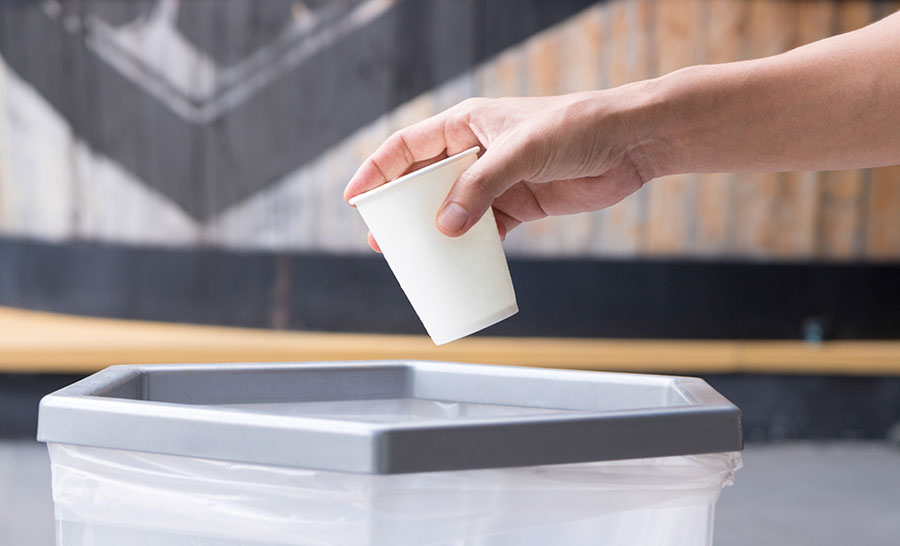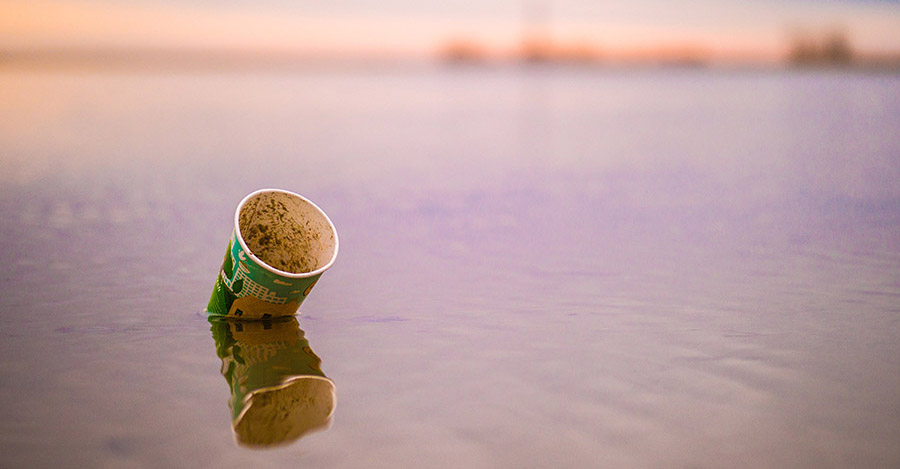In this article, we will explore:
- How many paper coffee cups are produced every year?
- What are paper coffee cups made of?
- Are paper coffee cups recyclable or compostable?
- Are coffee cups lids recyclable or compostable?
- Are paper coffee cups bad for your health?
- What are some sustainable alternatives to paper coffee cups?
How many paper coffee cups are produced every year?
According to the National Coffee Association, 63% of all Americans had a cup of coffee in the past day. Also, as of recent estimates, it is believed that approximately 500 billion paper coffee cups are produced worldwide each year.
While paper may seem innocent enough when it enters a landfill, its plastic lining makes the degradable material much more problematic.

What are Paper Coffee Cups Made Of?
Disposable coffee cups are made with a range of materials. Even if the cups aren’t made with the environmental villain Styrofoam, paper cups are often lined with equally problematic plastics.
Disposable coffee cups typically have a plastic resin, or polyethylene, lining. Polyethylene is a petroleum-based plastic, requiring thousands of barrels of oil to line our paper cups every single year.
Beyond the fossil fuel requirements, single-use plastics present another issue: proper disposal.

Are Paper Coffee Cups Recyclable or Compostable?
Because they are made with paper, you may incorrectly assume you can recycle paper cups. But coffee cups are able to contain hot liquids because they’re typically made with plastic-lined paper.
In the U.S., and around the world, most recycling programs are not capable of processing any plastic-coated cups or containers. Because plastic coatings contaminate the post-consumer paper material, roughly 99.75% of coffee cups can’t be recycled.
While the paper on its own can be composted, that plastic lining makes it impossible to do that. If a plastic-lined paper coffee cup is composted, it will contaminate the finished compost with microplastics and potentially toxic chemicals. There are alternatives in compostable coffee cups that are lined with a biofilm called PLA (more on that below).
Are coffee cups lids recyclable or compostable?
Lids are an essential part of single-use cups to prevent spills and burns. But just like the disposable paper cups, they come with their own set of problems.
Plastic lids are often made with polypropylene, or plastic #5. It’s one of the most common types of plastics because it’s lightweight and durable. Often these are not accepted by most residential recycling services. To sort, clean, and recycle the material requires more resources and has a higher cost than simply creating a new lid.
Even worse are the polystyrene (#6) coffee lids. We see foam coffee cups less and less, but the hard version of the material is still occasionally used in lids. Polystyrene has angered environmentalists and prompted city and state-wide bans because it’s one of the worst contributors to microplastics. The small pieces are found in animal stomachs, table salt, and drinking water.
Unfortunately, the problems associated with microplastics go beyond those of an environmental nature.
To sort, clean, and recycle polypropylene, or plastic #5, that coffee cup lids are often made with requires more resources and has a higher cost than simply creating a new lid.
Are paper coffee cups bad for your health?
Even if you’re sipping on a sugar-laden coffee drink, the high calories aren’t the only health concern. Those microplastics released from polystyrene? They’re associated with all types of plastic linings used in coffee cups.

A study published in the Journal of Hazardous Materials, found that plastic films (polypropylene included) release microplastics. These are considered hazardous and present health consequences. Within just 15 minutes, the plastic lining begins to degrade. Just three hot beverages a day could mean that someone ingests a whopping 75,000 microplastic particles.
While we don’t know the full impact these particles could have on our health, they have been linked with health issues. These include reproductive harm, metabolic disturbances, and an increased risk of cancer.
What are some sustainable alternatives to paper coffee cups?
Many people buying coffee cups now are looking for alternatives to paper coffee cups with petroleum-based plastic lining.
Fortunately, eco-friendly alternatives options that are certified compostable by BPI. Both cups below are also available as custom coffee cups as well!
- Paper hot cups with PLA lining take biodegradable paper coffee cups to the next level. These are made with PLA lining, a corn-based bioplastic that can withstand the heat of a hot drink. They are also made from FSC Certified paper.
- NoTree hot cups are also lined with PLA. They are made with zero tree paper but rather a rapidly renewable and unbleached bamboo paper. Also available in bowls and cold cups.
- cPLA and fiber lids are made from renewable plant-based materials. They are also spill-proof, easily withstand heat, and are certified compostable.
Ultimately, we can still enjoy drinking coffee or tea daily. But for the health the planet and ourselves, we should reconsider the materials in the hot cups we use. Traditional paper coffee cups are bad for the environment. When we consider that each sip might include microplastics, they’re also bad for our health.
Renewable, plant-based linings and lids are a modern improvement to coffee cups. This evolution is something that every coffee shop, cafe owner, and coffee connoisseur should embrace.




